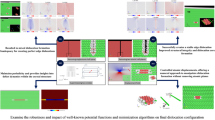Abstract
Hydrogen influenced change of dislocation mobility is a possible cause of hydrogen embrittlement (HE) in metals and alloys. A comprehensive understanding of HE requires a more detailed description of dislocation motion in combination with the diffusion and trapping of H atoms. A serious obstacle towards the atomistic modelling of a H interstitial in Fis associated with the role nuclear quantum effects (NQEs) might play evenat room temperatures, due to the small mass of the proton. Standard molecular dynamics (MD) implementations offer a rather poor approximation for such investigations as the nuclei are considered as classical particles. Instead, we reach for Ring-polymer MD (RPMD), the current state-of-the-art method to include NQEs in the calculations, which generates a quantum-mechanical ensemble of interacting particles by using MD in an extended phase space.
Here we report RPMD simulations of quantum effects on 1/2[111] edge dislocation motion in H charged Fe. The simulations results indicate that H atoms are more strongly confined to dislocation core and longer relaxation time is necessary for the edge dislocation to break away from the H atmosphere. The stronger interaction between dislocation and H atoms trapped in the core, resulting from NQEs, leads to formation of jogs along the dislocation line which reduce edge dislocation mobility in H charged Fe.
Access this chapter
Tax calculation will be finalised at checkout
Purchases are for personal use only
Similar content being viewed by others
References
Beachem, C.D.: A new model for hydrogen-assisted cracking (hydrogen “embrittlement’’). Metall. Mater. Trans. B 3, 441–455 (1972)
Robertson, I.M., Birnbaum, H.K.: An HVEM study of hydrogen effects on the deformation and fracture of nickel. Acta Metall. 34(3), 353–366 (1986)
Sofronis, P., Robertson, I.M.: Transmission electron microscopy observations and micromechanical/continuum models for the effect of hydrogen on the mechanical behaviour of metals. Philos. Mag. A 82(17–18), 3405–3413 (2002)
Robertson, I.M.: The effect of hydrogen on dislocation dynamics. Eng. Fract. Mech. 68(6), 671–692 (2001)
Ferreira, P.J., Robertson, I.M., Birnbaum, H.K.: Hydrogen effects on the interaction between dislocations. Acta Mater. 46(5), 1749–1757 (1998)
Birnbaum, H.K., Sofronis, P.: Hydrogen-enhanced localized plasticity – a mechanism for hydrogen-related fracture. Mater. Sci. Eng. A 176(1–2), 191–202 (1994)
Kirchheim, R.: Revisiting hydrogen embrittlement models and hydrogen-induced homogeneous nucleation of dislocations. Scripta Mater. 62(2), 67–70 (2010)
Craig, I.R., Manolopoulos, D.E.: A refined ring polymer molecular dynamics theory of chemical reaction rates. J. Chem. Phys. 123, 034102 (2005)
Habershon, S., Manolopoulos, D.E., Markland, T.E., Miller, T.F., III.: Ring-polymer molecular dynamics: quantum effects in chemical dynamics from classical trajectories in an extended phase space. Annual Rev. Phys. Chem. 64, 387–413 (2013)
Feynman, R.P., Hibbs, A.R.: Quntum Mechanics and Path Integral. McGraw-Hill, New York (1965)
Nose, S.: A unified formulation of the constant temperature molecular dynamics methods. J. Chem. Phys. 81(1), 511–519 (1984)
Swope, W.C., Andersen, H.C., Berens, P.H., Wilson, K.R.: A computer simulation method for the calculation of equilibrium constants for the formation of physical clusters of molecules: application to small water clusters. J. Chem. Phys. 76, 637 (1982)
Stukowski, A.: Visualization and analysis of atomistic simulation data with OVITO-the open visualization tool. Model. Simul. Mater. Sci. Eng. 18, 015012 (2009)
Kapil, V., et al.: i-PI 2.0: a universal force engine for advanced molecular simulations. Comput. Phys. Commun. 236, 214–223 (2019)
Ackland, G.J., Mendelev, M.I., Srolovitz, D.J., Han, S., Barashev, A.V.: Development of an interatomic potential for phosphorus impurities in \(\alpha \)-iron. J. Phys.: Condens. Matter 16(27), S2629–S2642 (2004)
Kimizuka, H., Ogata, S.: Slow diffusion of hydrogen at a screw dislocation core in \(\alpha \)-iron. Phys. Rev. B 84, 024116 (2011)
Hirth, J.P., Lothe, J.: Theory of Dislocations, 2nd edn. Wiley-Interscience, New York (1982)
Acknowledgements
This research was supported in part by the Bulgarian Science Fund under Grant KP-06-N27/19/ 17.12.2018, the Bulgarian Ministry of Education and Science (contract D01-205/23.11.2018) under the National Research Program “Information and Communication Technologies for a Single Digital Market in Science, Education and Security (ICTinSES)”, approved by DCM # 577/17.08.2018, and the European Regional Development Fund, within the Operational Programme “Science and Education for Smart Growth 2014–2020” under the Project CoE “National center of mechatronics and clean technologies” BG05M20P001-1.001-0008-C01.
Author information
Authors and Affiliations
Corresponding author
Editor information
Editors and Affiliations
Rights and permissions
Copyright information
© 2022 Springer Nature Switzerland AG
About this paper
Cite this paper
Katzarov, I., Ilieva, N., Drenchev, L. (2022). Quantum Effects on 1/2[111] Edge Dislocation Motion in Hydrogen-Charged Fe from Ring-Polymer Molecular Dynamics. In: Lirkov, I., Margenov, S. (eds) Large-Scale Scientific Computing. LSSC 2021. Lecture Notes in Computer Science, vol 13127. Springer, Cham. https://doi.org/10.1007/978-3-030-97549-4_15
Download citation
DOI: https://doi.org/10.1007/978-3-030-97549-4_15
Published:
Publisher Name: Springer, Cham
Print ISBN: 978-3-030-97548-7
Online ISBN: 978-3-030-97549-4
eBook Packages: Computer ScienceComputer Science (R0)




